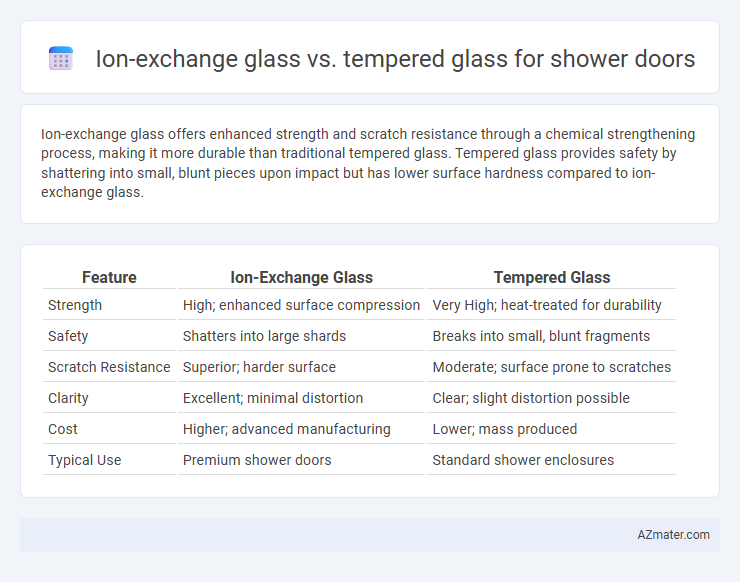Ion-exchange glass offers enhanced strength and scratch resistance through a chemical strengthening process, making it more durable than traditional tempered glass. Tempered glass provides safety by shattering into small, blunt pieces upon impact but has lower surface hardness compared to ion-exchange glass.
Table of Comparison
| Feature | Ion-Exchange Glass | Tempered Glass |
|---|---|---|
| Strength | High; enhanced surface compression | Very High; heat-treated for durability |
| Safety | Shatters into large shards | Breaks into small, blunt fragments |
| Scratch Resistance | Superior; harder surface | Moderate; surface prone to scratches |
| Clarity | Excellent; minimal distortion | Clear; slight distortion possible |
| Cost | Higher; advanced manufacturing | Lower; mass produced |
| Typical Use | Premium shower doors | Standard shower enclosures |
Introduction: Choosing the Best Shower Door Glass
Ion-exchange glass offers enhanced strength and scratch resistance through a chemical hardening process, making it a durable option for shower doors. Tempered glass undergoes thermal treatment, resulting in safety benefits such as shattering into small, less harmful pieces on impact. Evaluating factors like durability, safety, and maintenance helps determine the best glass type for a specific shower door application.
What is Ion-Exchange Glass?
Ion-exchange glass is a chemically strengthened glass created by replacing smaller sodium ions in the glass surface with larger potassium ions through an ion-exchange process, enhancing its strength and durability. This type of glass offers improved resistance to scratches, chips, and thermal stress compared to standard glass, making it a popular choice for shower doors that require long-lasting clarity and safety. Unlike tempered glass, which is heat-treated to increase strength and shatters into small granular pieces upon impact, ion-exchange glass maintains a clearer appearance with fewer distortions and resists damage without the risk of sudden breakage.
Understanding Tempered Glass
Tempered glass, used widely in shower doors, is a type of safety glass processed by controlled thermal or chemical treatments to increase its strength compared to regular glass. It shatters into small, blunt pieces when broken, reducing the risk of injury. Unlike ion-exchange glass, which undergoes a chemical strengthening process that enhances scratch resistance and durability, tempered glass focuses primarily on impact resistance and safety during breakage.
Strength and Durability Comparison
Ion-exchange glass offers enhanced strength through a chemical process that replaces smaller ions with larger ones, increasing surface compression and resistance to impact and scratches. Tempered glass undergoes thermal treatment that rapidly cools its surface, creating internal tension that makes it stronger and safer by shattering into small, blunt pieces when broken. While tempered glass is widely used for shower doors due to its high durability and safety features, ion-exchange glass provides superior scratch resistance and long-term structural integrity under repetitive stress conditions.
Safety Features: Which Is Safer?
Tempered glass offers superior safety for shower doors due to its strength and shatter-resistant properties; it breaks into small, blunt pieces that minimize injury risk. Ion-exchange glass, while durable and resistant to scratches, lacks the same breakage pattern and can create sharp shards when broken. For maximum safety in shower environments, tempered glass is the preferred choice because it meets stringent safety standards such as ANSI Z97.1 and CPSC 16 CFR 1201.
Scratch and Stain Resistance
Ion-exchange glass offers superior scratch resistance by undergoing a chemical strengthening process that compresses the surface, significantly reducing the likelihood of scratches from daily use. Tempered glass, while strong and resistant to impact, is more prone to surface scratches because it relies primarily on heat treatment without altering the glass's surface hardness. Ion-exchange glass also exhibits better stain resistance due to its smoother, denser surface, which repels water and mineral deposits more effectively than the slightly porous surface of tempered glass.
Visual Clarity and Aesthetic Appeal
Ion-exchange glass offers superior visual clarity compared to tempered glass due to its smoother surface and enhanced resistance to scratches and stains, maintaining a pristine, crystal-clear appearance over time. Tempered glass, while stronger and safer due to its shatter-resistant properties, often presents slight distortions or waves that can affect the overall aesthetic appeal of a shower door. For homeowners prioritizing sleek, spotless, and visually seamless bathroom designs, ion-exchange glass provides a refined, high-end look unmatched by traditional tempered glass.
Cost Differences and Value
Ion-exchange glass, made through an ion-exchange process that enhances surface strength, typically costs more upfront than tempered glass but offers superior scratch resistance and durability, providing long-term value for high-traffic shower doors. Tempered glass, widely used for its ability to shatter safely into small blunt pieces, is more affordable and balances safety with cost-effectiveness, making it a popular choice for standard shower installations. When considering cost differences and value, ion-exchange glass justifies its higher price through enhanced longevity and reduced maintenance, while tempered glass remains a budget-friendly option with reliable performance.
Installation and Maintenance Requirements
Ion-exchange glass for shower doors demands precise installation due to its enhanced strength achieved through chemical tempering, requiring professional handling to avoid damage. Tempered glass is more straightforward to install, with standard procedures sufficing, but it must be handled carefully to prevent stress points that lead to shattering. Maintenance for ion-exchange glass involves routine cleaning with non-abrasive agents to preserve its clarity and durability, while tempered glass requires similar care but is generally more resistant to surface scratches and chips.
Which Glass is Better for Your Shower Door?
Ion-exchange glass offers enhanced strength and durability through a chemical process that alters its surface composition, making it highly resistant to scratches and impacts, while tempered glass is heat-treated to improve toughness and shatters into small, blunt pieces for safety. For shower doors, tempered glass is commonly preferred due to its safety features; however, ion-exchange glass provides superior scratch resistance and longevity, ideal for maintaining a pristine appearance over time. Choosing between the two depends on prioritizing either impact safety or long-term clarity and durability in a humid, high-use environment.

Infographic: Ion-exchange glass vs Tempered glass for Shower door
 azmater.com
azmater.com